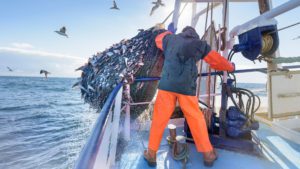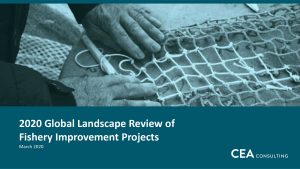The new report, 2022 Progress Toward Sustainable Seafood – By the Numbers (colloquially known in the sector as the Seafood Metrics Report), showcases the impact of sustainable seafood initiatives in the global seafood market.
2022 Progress Toward Sustainable Seafood - By the NumbersThe 2022 report is the seventh edition and builds upon six previous editions of the Seafood Metrics Report—from 2008, 2010, 2013, 2015, 2017, and 2020—to provide updated and readily available data on sustainable seafood efforts and impacts to the community of NGOs, businesses, and funders working on seafood and fisheries. The 2022 report serves as the last installment in the Seafood Metrics Report series and includes a retrospective section that reflects on the major trends and progress in the global seafood markets community, as highlighted through the Reports from 2008 through 2022. In addition, the report includes new, expanded information on climate and social responsibility.
The report, authored by CEA Consulting and jointly commissioned by the David and Lucile Packard Foundation and the Walton Family Foundation, seeks to highlight key data insights, emergent trends, and best practices in the evolving global sustainable seafood markets space. Since the first Seafood Metrics Report was published in 2008, the overall scope of markets-based approaches in the sustainable seafood markets space has evolved to include buyer engagements, broader geographies of engaged fisheries, expanded coverage of seafood commodities, production types, and supply chains, diversified stakeholder engagement, and more holistic systems-change interventions.
Key findings of this year’s report include:
- Global marine capture landings remain relatively stable, with the number of underfished stocks steadily decreasing since the mid-1970s. An estimated 65 percent of stocks are within biologically sustainable levels, although it is difficult to accurately account for IUU catch. An estimated 20-40 percent of stocks are now overexploited or collapsed.
- The COVID-19 pandemic caused significant disruption to the global seafood market, though it spurred adaptations in business strategy and practices across the seafood industry. The pandemic caused an estimated 22 percent decrease in US commercial landings revenue in 2020 and a 23 percent decrease in US seafood exports.
- About 17 percent of global production, excluding aquatic plants, is certified (by Marine Stewardship Council, Fair Trade USA, Aquaculture Stewardship Council, or Best Aquaculture Practices) or rated Seafood Watch “Best Choice” and “Good Alternative,” as reported on the Certification and Ratings Collaboration 2021 Sustainable Seafood Data Tool.
- More than 85 percent of the top US, Canadian, and European retailers have commitments to sustainable seafood, with few major changes in the commitment landscape in recent years. A 2021 analysis from CEA Consulting determined that the majority of companies in surveyed sustainable seafood precompetitive collaborations are retailers, suppliers, and distributors domiciled in North America and Europe.
- Leading regional and national import control schemes to combat IUU fishing include the EU Regulation to end IUU, of which three countries—Cambodia, Comoros, and St. Vincent and Grenadines—remain red carded. NGO and for-profit traceability initiatives, such as The Ocean Disclosure Project and Global Fishing Watch remain critical in combatting IUU fishing and upholding accountability in global seafood supply chains.
- The landscape of actors operating in social responsibility in seafood is broad, spanning human and labor rights NGOs and consultants operating in the seafood sector, precompetitive collaborations, FIP implementers, funders, industry, environmental NGOs and more. There is plenty of work to be done—the World Benchmarking Alliance’s 2022 Sustainable Seafood Index found that half of reviewed companies lack a comprehensive commitment to protect human rights in their operations and supply chains and one-third of companies do not have a commitment to respect the health and safety of workers in their operations and supply chains.
Partner perspectives
Our Shared Seas checked in with partners from the Packard Foundation and Walton Family Foundation to understand how their respective teams have used the Seafood Metrics Report and where they see emerging priorities for the sustainable seafood landscape.
“The field has changed so much over the years, and the Seafood Metrics Report has provided important markers in time. We’ve used this report to track our progress and onboard staff and trustees who are new to the sustainable seafood space. This report was important for us to contribute to, following the joint Global Seafood Markets Evaluation because it helped us understand the how much the landscape has changed over time and anchor the findings of the evaluation in a time series.”
—Teresa Ish, Oceans Initiative Lead and Senior Program Officer, Walton Family Foundation
“I’m excited to see continued movement toward more focused and collaborative efforts (both NGO coalitions that are seeking alignment as well as business pre-competitive collaborations) to address the biggest risks to fisheries and ocean ecosystem health—overfishing and IUU fishing—along with the recognition that these drivers of environmental degradation are inextricably linked to impacts on human well-being, livelihoods, and worker rights. Of course, significant additional work to build understanding, political and corporate will, and shift practices and policies are still needed. I see this being a big part of the future focus of this movement.”
—Sarah Hogan, Program Officer, Global Seafood Markets Strategy, Packard Foundation
“It’s inspiring to see how much the seafood markets movement has continually grown in size and importance. So many partners have reached the inevitable conclusion that social and environmental sustainability are essential to the long-term viability of the seafood industry and have prioritized efforts in that direction. By now, every business should have the tools and resources needed to reach that conclusion. Pressure will continue to grow from consumers and governments to increase corporate accountability, while recognizing stakeholders with true positive impacts on ocean health and livelihoods.”
—Leo Pradela, Program Officer, Walton Family Foundation
We encourage you to dive into the 2022 Seafood Metrics Report to learn about the evolution of trends in the sustainable seafood landscape.
Downloads

Visit the following links to read previous Seafood Metrics Reports.
If you have questions or feedback about the report, please contact Sydney Sanders at sydney@ceaconsulting.com or Tanya Mahadwar at tanya@ceaconsulting.com



